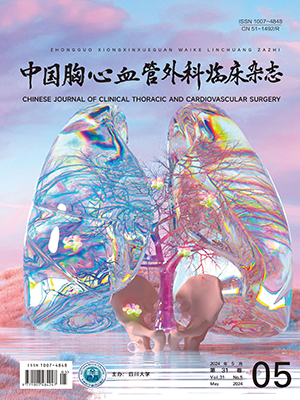| 1. |
Licker MJ, Widikker I, Robert J, et al. Operative mortality and respiratory complications after lung resection for cancer: impact of chronic obstructive pulmonary disease and time trends. Ann Thorac Surg, 2006, 81(5): 1830-1837.
|
| 2. |
Brunelli A, Kim AW, Berger KI, et al. Physiologic evaluation of the patient with lung cancer being considered for resectional surgery: Diagnosis and management of lung cancer, 3rd ed: American College of Chest Physicians evidence-based clinical practice guidelines. Chest, 2013, 143(5 Suppl): e166S-e190S.
|
| 3. |
Ribas J, Jiménez MJ, Barberà JA, et al. Gas exchange and pulmonary hemodynamics during lung resection in patients at increased risk: relationship with preoperative exercise testing. Chest, 2001, 120(3): 852-859.
|
| 4. |
Gottlieb M, Marsaa K, Godtfredsen NS, et al. Prevalence and management of pulmonary comorbidity in patients with lung and head and neck cancer. Acta Oncol, 2015, 54(5): 767-771.
|
| 5. |
支修益, 何建行, 刘伦旭, 等. 多学科围手术期气道管理专家共识(2016 年版). 中国胸心血管外科临床杂志, 2016, 21(7): 641-645.
|
| 6. |
Benzo R, Wigle D, Novotny P, et al. Preoperative pulmonary rehabilitation before lung cancer resection: results from two randomized studies. Lung Cancer, 2011, 74(3): 441-445.
|
| 7. |
Bölükbas S, Eberlein M, Eckhoff J, et al. Short-term effects of inhalative tiotropium/formoterol/budenoside versus tiotropium/formoterol in patients with newly diagnosed chronic obstructive pulmonary disease requiring surgery for lung cancer: a prospective randomized trial. Eur J Cardiothorac Surg, 2011, 39(6): 995-1000.
|
| 8. |
Lai Y, Su J, Yang M, et al. Impact and effect of preoperative short-term pulmonary rehabilitation training on lung cancer patients with mild to moderate chronic obstructive pulmonary disease: A randomized trial. Zhongguo Fei Ai Za Zhi, 2016, 19(11): 746-753.
|
| 9. |
Refai M, Brunelli A, Xiumé F, et al. Short-term perioperative treatment with ambroxol reduces pulmonary complications and hospital costs after pulmonary lobectomy: a randomized trial. Eur J Cardiothorac Surg, 2009, 35(3): 469-473.
|
| 10. |
Stefanelli F, Meoli I, Cobuccio R, et al. High-intensity training and cardiopulmonary exercise testing in patients with chronic obstructive pulmonary disease and non-small-cell lung cancer undergoing lobectomy. Eur J Cardiothorac Surg, 2013, 44(4): e260-e265.
|
| 11. |
倪高顺, 陈洋. 综合物理治疗对肺癌合并慢性阻塞性肺疾病患者术后肺功能的影响. 中国呼吸与危重监护杂志, 2017, 16(4): 318-323.
|
| 12. |
方翼, 赵擎宇, 黄东锋, 等. 运动训练对低肺功能肺癌患者手术耐受性的影响. 中国康复医学杂志, 2013, 28(7): 619-623.
|
| 13. |
贺斌, 李新, 张鹏, 等. 术前运动训练对肺癌合并 COPD 患者围术期心肺功能的影响. 山东医药, 2015, 55(18): 21-23.
|
| 14. |
Borges RC, Carvalho CR. Impact of resistance training in chronic obstructive pulmonary disease patients during periods of acute exacerbation. Arch Phys Med Rehabil, 2014, 95(9): 1638-1645.
|
| 15. |
Bobbio A, Chetta A, Ampollini L, et al. Preoperative pulmonary rehabilitation in patients undergoing lung resection for non-small cell lung cancer. Eur J Cardiothorac Surg, 2008, 33(1): 95-98.
|
| 16. |
沈春辉, 梅龙勇, 喻鹏铭, 等. 术前肺康复对肺癌合并中-重度慢性阻塞性肺疾病患者运动耐力的影响. 中国胸心血管外科临床杂志, 2011, 18(6): 514-517.
|
| 17. |
申瑞娟, 杨鲁民, 李靖, 等. 中重度 COPD 并肺癌患者围手术期肺功能保护的临床研究. 中国现代医学杂志, 2011, 21(28): 3551-3554.
|
| 18. |
郭志强. 中重度 COPD 并肺癌老年患者围术期肺功能的变化及保护. 中国老年学杂志, 2013, 33(22): 5559-5560.
|
| 19. |
Kobayashi S, Suzuki S, Niikawa H, et al. Preoperative use of inhaled tiotropium in lung cancer patients with untreated COPD. Respirology, 2009, 14(5): 675-679.
|
| 20. |
Divisi D, Di Francesco C, Di Leonardo G, et al. Preoperative pulmonary rehabilitation in patients with lung cancer and chronic obstructive pulmonary disease. Eur J Cardiothorac Surg, 2013, 43(2): 293-296.
|
| 21. |
Matsuura Y. Effectiveness of NRST about preoperative management of respiratory surgery in our hospital. Chest, 2011, 140(4): 527A.
|
| 22. |
Mujovic N, Mujovic N, Subotic D, et al. Influence of pulmonary rehabilitation on lung function changes after the lung resection for primary lung cancer in patients with chronic obstructive pulmonary disease. Aging Dis, 2015, 6(6): 466-477.
|
| 23. |
Sekine Y, Chiyo M, Iwata T, et al. Perioperative rehabilitation and physiotherapy for lung cancer patients with chronic obstructive pulmonary disease. Jpn J Thorac Cardiovasc Surg, 2005, 53(5): 237-243.
|
| 24. |
Nojiri T, Inoue M, Yamamoto K, et al. Inhaled tiotropium to prevent postoperative cardiopulmonary complications in patients with newly diagnosed chronic obstructive pulmonary disease requiring lung cancer surgery. Surg Today, 2014, 44(2): 285-290.
|
| 25. |
Saito H, Hatakeyama K, Konno H, et al. Impact of pulmonary rehabilitation on postoperative complications in patients with lung cancer and chronic obstructive pulmonary disease. Thorac Cancer, 2017, 8(5): 451-460.
|
| 26. |
Torre LA, Bray F, Siegel RL, et al. Global cancer statistics, 2012. CA Cancer J Clin, 2015, 65(2): 87-108.
|
| 27. |
Caramori G, Casolari P, Cavallesco GN, et al. Mechanisms involved in lung cancer development in COPD. Int J Biochem Cell Biol, 2011, 43(7): 1030-1044.
|
| 28. |
McLeod RS, Aarts MA, Chung F, et al. Development of an enhanced recovery after surgery guideline and implementation strategy based on the knowledge-to-action cycle. Ann Surg, 2015, 262(6): 1016-1025.
|
| 29. |
Ries AL, Bauldoff GS, Carlin BW, et al. Pulmonary rehabilitation: joint ACCP/AACVPR evidence-based clinical practice guidelines. Chest, 2007, 131(5 Suppl): 4S-42S.
|
| 30. |
中国加速康复外科专家组. 中国加速康复外科围手术期管理专家共识(2016). 中华外科杂志, 2016, 54(6): 413-418.
|
| 31. |
Lee SH, Kim N, Lee CY, et al. Effects of dexmedetomidine on oxygenation and lung mechanics in patients with moderate chronic obstructive pulmonary disease undergoing lung cancer surgery: A randomised double-blinded trial. Eur J Anaesthesiol, 2016, 33(4): 275-282.
|
| 32. |
Vagvolgyi A, Rozgonyi Z, Kerti M, et al. Effectiveness of perioperative pulmonary rehabilitation in thoracic surgery. J Thorac Dis, 2017, 9(6): 1584-1591.
|
| 33. |
Laurent H, Galvaing G, Thivat E, et al. Effect of an intensive 3-week preoperative home rehabilitation programme in patients with chronic obstructive pulmonary disease eligible for lung cancer surgery: a multicentre randomised controlled trial. BMJ Open, 2017, 7(11): e017307.
|




